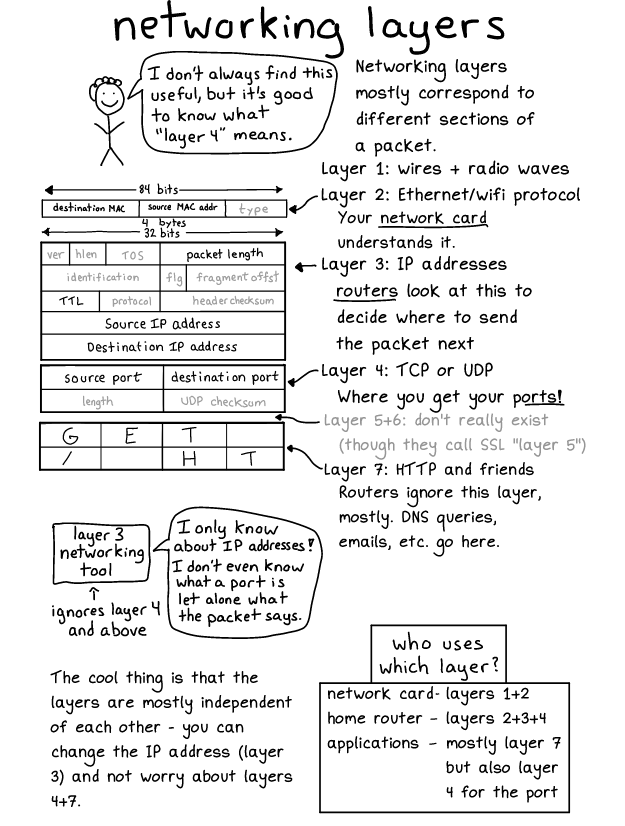TCP/IP is the set of networking protocols that we use on the modern internet – TCP, UDP, IP, ARP, ICMP, DNS, etc. When I talk about “networking”, I’m basically always talking about TCP/IP.
Many explanations of TCP/IP start with something called the “OSI model”. I don’t use the OSI model when explaining networking because when I first started learning about internet networking I found all of the OSI model explanations really confusing – it wasn’t clear to me at all how the OSI model corresponded to TCP/IP.
So if you’re just starting to learn about networking and you’re confused about the OSI model, here’s an explanation of how it corresponds to TCP/IP, how it doesn’t, and why it’s safe to mostly just ignore it if you don’t find it helpful.
the OSI model has 7 layers
Let’s very briefly discuss what the OSI model is: it’s an abstract model for how networking works with 7 numbered layers:
- Layer 1: physical layer
- Layer 2: data link
- Layer 3: network
- Layer 4: transport
- Layer 5: session
- Layer 6: presentation
- Layer 7: application
I won’t say more about what each of those is supposed to mean, there are a thousand explanations of it online.
how the OSI model corresponds to TCP/IP
Some parts of the OSI model do correspond to TCP/IP. Basically for any TCP or UDP packet you can split up the packet into different sections and give each section a layer number.
- Layer 2 corresponds to Ethernet
- Layer 3 corresponds to IP
- Layer 4 corresponds to TCP or UDP (or ICMP etc)
- Layer 7 corresponds to whatever is inside the TCP or UDP packet (for example a DNS query)
Here’s a diagram from my Networking! ACK! zine showing how you can assign layers to different parts of a packet.
I just noticed that for some reason this is a UDP packet containing the start of a HTTP request which is unrealistic, but let’s go with it, you could make a UDP packet like that if you wanted :). I think I did that to save space.

Now that we’ve talked about how the OSI model does correspond to TCP/IP, let’s talk about how it doesn’t!
people refer to layers 2, 3, 4, and 7 all the time
It’s important to know about the OSI model because the terms “layer 2”, “layer 3”, “layer 4” and “layer 7” are used a LOT. You’ll hear about “layer 2 routing”, “layer 7 load balancers”, “layer 4 load balancers”, etc.
So even thought I don’t really use those terms myself when talking about networking, I need to understand them to be able to read documentation and understand what people are saying.
there’s no layer 5 or 6 in TCP/IP
I’ve heard a few different interpretations of what layers 5 or 6 could mean in TCP/IP, including:
- TLS is layer 6
- TCP is actually layers 5 + 6 + 7 smushed together
But layers 5 and 6 definitely don’t have a clear correspondence like “every layer has a corresponding header in the TCP packet” the way layers 2, 3, and 4 do.
And I’ve never seen anyone actually refer to layer 5 or 6 in practice when talking about TCP/IP, even though people talk about layers 2, 3, 4, and 7 all the time.
what layer is an ARP packet?
Also, some parts of TCP/IP don’t fit well into the OSI model even around layers 2-4 – for example, what layer is an ARP packet?
ARP is a protocol for discovering what MAC address corresponds to an IP address: when a machine wants to know who has a certain IP address, it sends out an ARP message saying “help! who is 192.168.1.1?” and it’ll get a response from the owner of the IP saying “it’s me! I’m 192.168.1.1”
ARP packets contain IP addresses and IP addresses are layer 3, but when people talk about “layer 3” packets they usually mean a packet which have an IP header, and ARP packets don’t have an IP header, they just have an Ethernet header and then some data on top of that which contains an IP.
the OSI model is a literal description of some obsolete protocols
So, if the OSI model doesn’t literally describe TCP/IP, where did it come from?
Some very brief research on Wikipedia says that in addition to an abstract description of 7 layers, the OSI model also contained a bunch of specific protocols implementing those layers. Apparently this happened during the Protocol Wars in the 70s and 80s, where the OSI model lost and TCP/IP won.
This explains why the OSI model doesn’t really correspond that well to TCP/IP, since if the OSI protocols had “won” then the OSI model would correspond exactly to how internet networking actually works.
you can talk about specific network protocols instead of using layer numbers
When talking about networking, instead of using numbered layers I like to instead just talk about specific networking protocols I mean. Like instead of “layer 2” I’ll use something like “Ethernet” or “MAC address”. I’ve written many blog posts talking about MAC addresses and zero posts talking about “layer 2”.
As another example, when talking about load balancers usually I say “HTTP load balancer” instead of “layer 7 load balancer”. Basically every layer 7 load balancer I’ve used has been a HTTP load balancer, and if it’s not using HTTP then I’d rather know which other protocol it’s using!
that’s all!
Hopefully this will help clear things up for somebody! I wish someone had told me when I started learning networking that I could just learn approximately how layers 2, 3, 4, and 7 of the OSI model relate to TCP/IP and then ignore everything else about it.